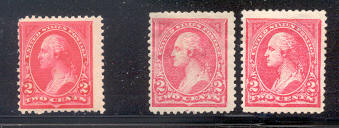
(Click image for 300 dpi scan)
| US Postal Counterfeits |
| Stampsjoann (click here) |
2¢ Washington, 1894
An ad appeared on Mar 31, 1895 in the Chicago Tribune,
in which a novelty agency from Ontario offered two cent US stamps for sale,
the first class domestic US letter rate. The ad signaled the first known
attempt to defraud the United States Post Office Department (USPOD).
The stamps offered were actually counterfeit stamps of the two cent carmine George Washington issue. According to H.K. Petschel in his book, Spurious Stamps: A History of U.S. Postal Counterfeits, published by the American Philatelic Society in 1997, the counterfeits were of the 1894 issue, Scott 250 Type I triangle, Krause-Minkus (K-M) 172 Type I. The USPOD stamps were engraved; the counterfeits were lithographed. In a March 1992 Linn's article, Wayne Youngblood reported that mint counterfeit copies with the Type III triangle were also known.
Examples shown are the Type I triangle. On the left is a Scott 250; the other "stamps" are counterfeits.

(Click image for 300 dpi scan) |
2¢ Washington Franklin
The eBay description by the seller of this 2¢ counterfeit, the
stamp on the right, said that it was "printed by offset lithography; hand
done on a plate of ten stamps; each was different."
The Washington Franklin series extended from 1908-1922; many varieties of the USPOD stamps were produced during that time period. Some of the 2¢ stamps can be identified by minute variances of the engraved lines on certain parts of the stamp, for example in the hairlines on the head.
Most of the 2¢ Washingtons of this series were engraved stamps. The used Scott 528, K-M 404B, illustrated on the left, was one of the first examples of offset printing by the Bureau of Engraving and Printing (BEP). This offset printing resulted from a shortage of high quality steel and barites. The steel was needed for the printing plates and the barites for the inks.
Counterfeits of the Washington Franklin 2¢ value (first class domestic letter rate) were found in many cities: St. Louis, 1916; Minneapolis, 1919; West Allenhurst, NJ, 1921; New York City, 1922-1923; Toledo, 1923.
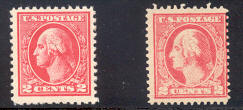
(Click image for 300 dpi scan) |
2¢ Washington of the Fourth
Bureau
The following two counterfeits are both copies of the 2¢ Fourth
Bureau issue. Although sometimes called Scott 554, K-M 421, or Scott 634,
K-M 476, philatelic writer Ken Lawrence suggests that the postal counterfeits
of this Fourth Bureau issue (1922-1934) be referenced by the stamp design,
Scott A157, the Type I of this series.
The 554 is a flat plate printing, perforated 11, issued in 1923; the 634 is a rotary press printing, perf 11 x 10½, issued in 1926. The counterfeits were not made using the same printing methods or perforations. One might find a counterfeit of design A157 called either a 554 or a 634.
Some counterfeits were perforated gauge 14, while others were perf 12. In a Scott Stamp Monthly article, Nov 2000, Gary Griffith suggested the perf 12 followed the 14 because the counterfeiters may have been trying to make the fakes look more like the real stamps.
A large "S" in WASHINGTON under the vignette is typical of these counterfeits. Although these counterfeits might be called the "Boston", "New Jersey", or other names, more than likely all were printed in the New York City area.
On the left is Scott stamp design A157 (Scott 554, K-M 421). The counterfeits are on the right.

(Click image for 300 dpi scan) |
On the left is Scott stamp design A157, Type I (Scott 634, K-M 476). Counterfeits are to the right.

(Click image for 300 dpi scan) |
3¢ Jefferson, Presidential
Series
The 3¢ Jefferson, Scott 807, K-M 528, perforated 11 x 10½,
was first issued on June 16, 1938. The first class letter rate was 3¢
from July 6, 1932 to July 31, 1958. The 3¢ Jefferson, part of the
Presidential Series of stamps, was a main stay to meet that rate even after
the next regular issue series (the Liberty Series) was printed starting
in 1954. According to H.K. Petschel, the postal counterfeits of the 3¢
Jefferson issue were "photographically reproduced and printed from lithograph
plates."
The counterfeits were printed in panes of 100 stamps, but, unlike the real stamps, had no plate numbers or marginal markings.
Some counterfeits were reportedly perforated 12; other examples were discovered as imperforate copies like the mint pair shown on the right. A perforated 807 is to the left.
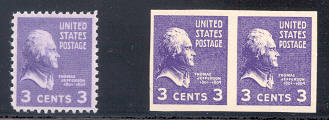
(Click image for 300 dpi scan) |
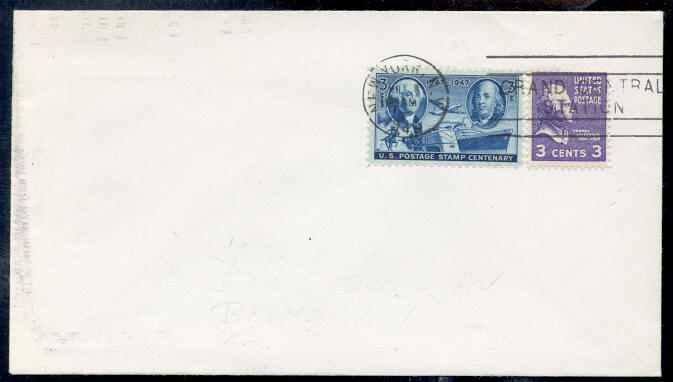
(Click image for 300 dpi scan) |
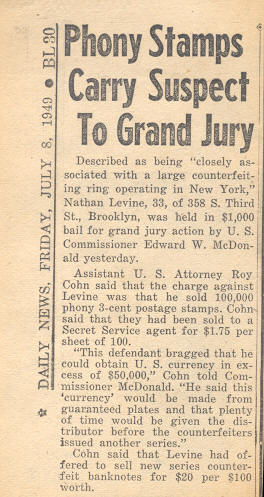 |
4¢ Lincoln, Liberty Series
Scott 1036, K-M 574, was issued in July, 1956. In the fall of 1961
postal inspectors were investigating whether 4¢ Lincoln stamps were
being counterfeited and distributed in Pennsylvania and New York. In early
November a notice was sent to all postmasters in New York state advising
them to be on the lookout for 4¢ Lincoln counterfeits used in the
mails; window clerks were also advised to have any persons attempting to
sell or redeem 4¢ stamps provide identification.
Counterfeits could easily be identified by lack of detail in the design, for instance missing hair lines in the beard and head; also the perforations were finer gauged and the gum had no breakers.
Petschel learned that this was not a small operation. Seven million dollars in counterfeit stamps went to Baltimore and $500,000 worth were sold in vending machines in New York City. However, he believed that distribution may have been disrupted when three subjects were arrested (and later found guilty) in Pittsburgh.
Scott 1036, perforated 11 x 10½, is on the left. Besides lacking the fine detail of the engraved postal stamp, the counterfeit on the right has white areas over Lincoln's shoulders.
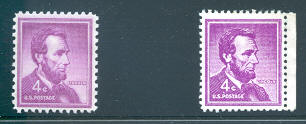
(Click image for 300 dpi scan) |
13¢ Kennedy, Prominent American
series
Issued May 29, 1967, the 13¢ Kennedy, Scott 1287, K-M 625, could
be properly used for foreign airmail post cards until July 1, 1971. When
the domestic letter rate became 13¢ (Dec 31, 1975 - May 28, 1978),
the stamp satisfied that surface letter rate.
It was during this later usage period that counterfeits of the 13¢ Kennedy were found in Providence, RI. According to Petschel, postal inspectors had received a tip that there might be counterfeit stamps in the Rhode Island area and reviewed mail coming off the Mark II facer/canceler on Sept 21, 1977. (The Mark II was equipped to detect the position of a phosphor tagged stamp and to then cancel the stamp.)
Bogus stamps have not been found with tagging; and according to Petschel, counterfeiters were aware that items rejected by the facer/canceler were not inspected. Search warrants were issued on Sept 29 and about 10,000 counterfeit stamps were recovered in the Rhode Island area.
Kennedy counterfeits were also found in Boston and Chicago; it was discovered that there were three printing plants, in Boston, Chicago and New York City.
The counterfeit examples below were produced from a set repeat printing plate. In a Scott Stamp Monthly article, Feb 2000, Petschel explained this process as... "one stamp was photographed, touched up, and then duplicated over and over to make the master plate." This particular counterfeit has a dot over the "c" in 13c which appears in both copies below.
Some other counterfeit Kennedy stamps were produced using a half-tone screen printing method: a series of dots on the paper produces the image. Half-tone products have a smudged appearance rather than an engraved look. Four counterfeit stamps were known to have been made using the half-tone screen process: 13¢ Kennedy, 10¢ Jefferson Memorial, 13¢ Liberty Bell, and 13¢ airmail.
The misperfed counterfeits are on the right. A similarly misperfed plate numbered strip of the post office stamps is on the left.

(Click image for 300 dpi scan) |
6¢ Eisenhower, Regular Issue/Prominent
American Series
The 6 cent Eisenhower sheet stamp, Scott 1393, K-M 652 was issued on
August 6, 1970. Scott calls this a Regular Issue; K-M includes it in the
Prominent American Series. The stamp was engraved, printed by rotary press,
perforated 11 x 10½. The stamp could be used for the 6¢ first
ounce letter rate which began on January 7, 1968 and continued until May
15, 1971.
In the August 1971 issue of the American Philatelist, the American Philatelic Expertising Service reported that counterfeit 6¢ Eisenhowers existed adding that the only way the counterfeits resembled the real stamps was in the design. A comparison of the real Eisenhowers and the counterfeits found these differences: The counterfeits were lithographed; the paper was whiter; the gum was whiter with no ridges; perforations were 10½; the perf holes were somewhat larger; the color was darker, and the design lines were less distinct especially right and left of Eisenhower's head.
H.K. Petschel reported in Spurious Stamps that there were several reports of counterfeit 6¢ Eisenhowers on the East Coast of the USA in 1969-1971. Counterfeits were found being used in the Chicago area in 1973. A report by the Chicago Organized Crime Strike Force stated that some "persons involved in this investigation were identified as being associates of organized crime..."
Wayne Youngblood stated in a June 1990 Linn's article that a counterfeit 6¢ was offered in a Canadian auction. In 1991 he reported that a New Jersey dealer discovered some plate blocks, lower right #31920, in a postage lot.
Although counterfeiters are sometimes apprehended and imprisoned, and sometimes presses are confiscated and stamps seized, usage of postal counterfeits often continues for years after.
The real 1393 is on the left; the counterfeit is on the right.
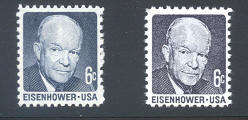
(Click image for 300 dpi scan) |
8¢ Eisenhower, Regular Issue/Prominent
American Series
The 8 cent Eisenhower sheet stamp, Scott 1394, K-M 663, was issued
on May 10, 1971. Scott refers to this as a Regular Issue stamp. K-M considers
it part of the Prominent American Series. This stamp could be used on first
class letters when the postal rate increased to 8¢ on May 16, 1971.
In Feb 1974, an eight cent Eisenhower counterfeit was discovered on a cover in State College PA, then home of the American Philatelic Society (APS). A detailed description of the item appeared in the American Philatelist, journal of the APS, in Apr 1974. Differences noted between the authentic stamp and the fake included the duller colors of the fake, the misalignment of the letters of EISENHOWER and USA, and poor formation of those letters.
On the left is a postal service Eisenhower stamp; and on the right, an imperforate postal counterfeit.
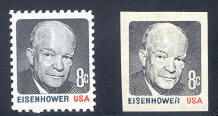
(Click on image for 3000 dpi) |
10¢ Crossed Flags
Scott 1509, K-M 676, was issued on Dec 8, 1973. The ten cent first
class letter rate began on May 2, 1974. About two years later counterfeits
were discovered in Chicago. A mail screening found 1,500 letters bearing
the counterfeit 10¢ flags "leading to the identification of one major
supplier, six major sellers, and 275 individual users of the bad stamps."
(Spurious Stamps) Petschel added that this was a small-time
operation but more than a million stamps were involved. Counterfeits were
being found used as late as Dec 1979.
This counterfeit block of twelve was illustrated on the front page of Stamp Collector, Dec 6, 1999. Fred Baumann described the size of the stamps as varying from 22mm high to 23.5mm high because of misaligned horizontal perforations. The variance in size of the stamps from left to right is easy to tell in the block below. The single stamp is a genuine copy.
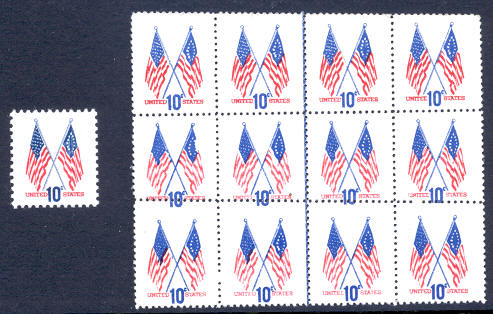
(Click image for 300 dpi scan) |
10¢ Jefferson Memorial
The 10¢ Jefferson Memorial sheet stamp was issued on December
14, 1973. The ten cent first class letter rate began the following year
on May 2, 1974.
Some of the counterfeits of Scott 1510, K-M 678, were produced by the half-tone screen printing described under the Kennedy stamp. The imperf pair below exhibit the smudged appearance that results from this printing method.
In July and September of 1974, several arrests were made in Philadelphia in connection with counterfeit 10 cent Jefferson Memorial stamps. Nearly 500,000 counterfeits were recovered in the two series of arrests.
In Nov 1976, over 150,000 counterfeit ten cent Jefferson Memorials were seized in Nesconset, NY. These stamps had been packaged in the manner the Bureau of Engraving and Printing used; packages of 100 panes, each pane consisting of 100 stamps, wrapped in kraft paper with an identifying cover sheet. Petschel suspected that these "decks" might have been intended to be inserted in accountable paper of the postal service.
Scott 1510, issued Dec 13, 1973, is on the left.
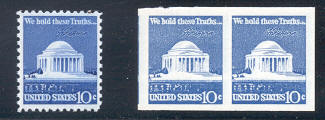
(Scan image for 300 dpi scan) |
13¢ Liberty Bell, Americana
Series
The 13¢ Liberty Bell was issued on October 31, 1975, two months
before the first class letter rate became thirteen cents on December 31,
1975.
The 13¢ Liberty Bell is known to have been counterfeited in at least three different forms: the half-tone screen printing and the step repeat method (both described in the Kennedy write-up) and a coil version.
A mistake made by some counterfeiters of this stamps was producing counterfeits in sheet format with perforations on all four sides. The postal service stamps, Scott 1595, K-M 695, were produced as booklet stamps with three sides perforated; the Scott 1618, K-M 696 stamps were coils perforated vertically. This issue was not produced in sheet format so stamps perfed on all four sides are counterfeits.
In Rhode Island, Nov 1976, a person known to have connections with organized crime was found dead from a shotgun blast; $3,000 worth of counterfeit 13¢ Liberty Bell sheet stamps were next to his body. Soon after, millions of the stamps were found by Boston inspectors floating in the bay. Petschel stated that "somebody didn't want them on the market." (Spurious Stamps)
Previously, in June 1976, some counterfeiters had tried to produce stamps that could pass as coils or booklet stamps. Arrests were made in Ohio in regards to 500,000 13¢ Liberty Bell stamps. These were produced as horizontal strips of four with no perforations top or bottom, nor on the right hand edge of the strip. An effort seems to have been made to use the formats in which the real stamps were produced.
The line pair coil stamps on the left are Scott 1618; the counterfeit with all sides perfed is on the right.
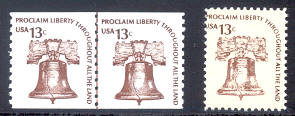
(Click image for 300 dpi scan) |
20¢ Truman, Great American
Series
Postal counterfeiters tend to choose stamps of a single color and usually
a regular issue stamp. Many of the postal counterfeits in this collection
follow that pattern. The Truman counterfeit is another single color stamp.
The 20¢ Truman, Scott 1862, K-M 811 and 904, has two distinct perforation varieties, at least two gum varieties and several tagging varieties.
Originally issued on Jan 26, 1984, this stamp satisfied the first class domestic letter rate until Feb 17, 1985. From Apr 3, 1988 to Feb 2, 1991, 20¢ was the extra ounce rate for a domestic letter. The post card rate was 20¢ from Jan 1, 1995 to June 30, 2001, so the Truman stamp could have been used for many postal purposes. According to Steve Esrati in The Great Americans (and a few Distinguished Americans), the stamp was withdrawn from sale at the Philatelic Fulfillment Service Center on June 30, 1997.
The real stamp on the left is the first variety, perf 10.9, small block tag, dull or matte gum. The eBay seller described the counterfeit as "a crudely lithographed and perforated copy, canceled on piece."
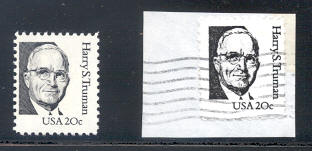
(Click image for 300 dpi scan) |
29¢ Flags on Parade
When issued on May 30, 1991, commemorating the 125th anniversary of
Memorial Day, the Flags on Parade stamps (Scott 2531, K-M 956) met the
first class letter rate which extended from Feb 3, 1991 to Dec 31, 1994.
The stamp has two tagging types, an overall tag and phosphored paper.
The fakes, below in a strip of four and a strip of six, were purchased from a collector, George P. Wagner, who found them in New Orleans in 1993 and wrote about them in Stamp Collector, Feb 2002. George said he was told the stamps may have originated in Taiwan. <click here for the article>
The horizontal plate layout seems to be six across as there is selvage on both sides. The vertical size of the plate is unknown; all copies known so far are in strips. Two color types seem to exist, one with a mustard- yellow background and another with a white background. The paper is unwatermarked and ungummed. The "stamps" are rouletted, while the postal service copies are perforated on four sides.
In his "For the Record" column of Stamp Collector, Mar 25, 2002, editor/publisher Wayne Youngblood printed a response to the February article. A reader in New Jersey who won a best one frame award in Sept 1992 described his prize... "a cylindrical paper weight/stamp dispenser about 2" in diameter and 1-5/8" high with a screw off lid and a 1-1/8" vertical slit on the side... On the bottom is a little sticker that reads 'MADE IN TAIWAN/R.O.C.'" <click here for the article>
The reader also said that the container had a strip of the yellowish stamps that originally may have been 5 to 6 stamps long. The strip of four kept by the reader was slightly different from the counterfeit strips pictured below; the strip from this container had selvage on the left end and the bottom. These fakes may have been from the bottom of the printed sheet and then cut into strips.
The single Scott 2531 shown below is an overall tag variety. The strips are easily identified as "copies."

(Click image for 300 dpi scan) |
Is this a modern counterfeit... a dummy test coil or????
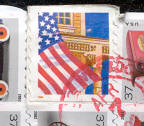 |
| Stampsjoann (click here) |